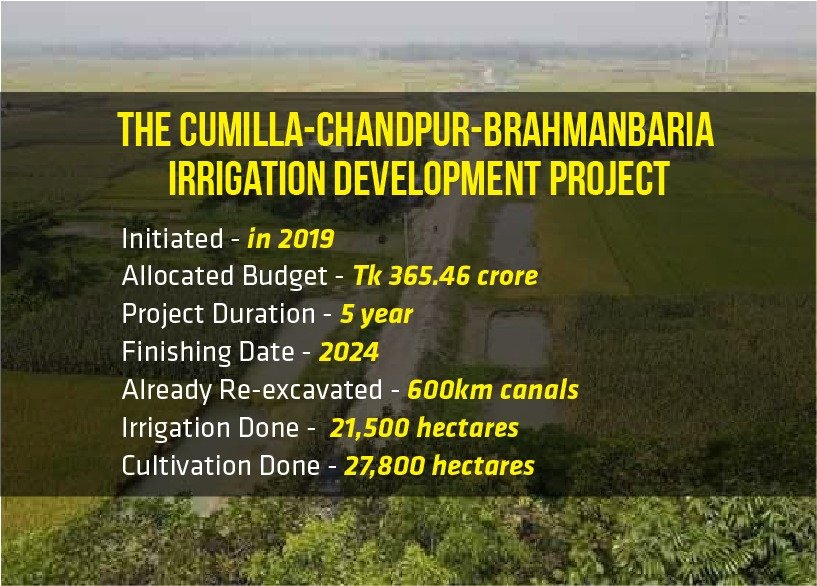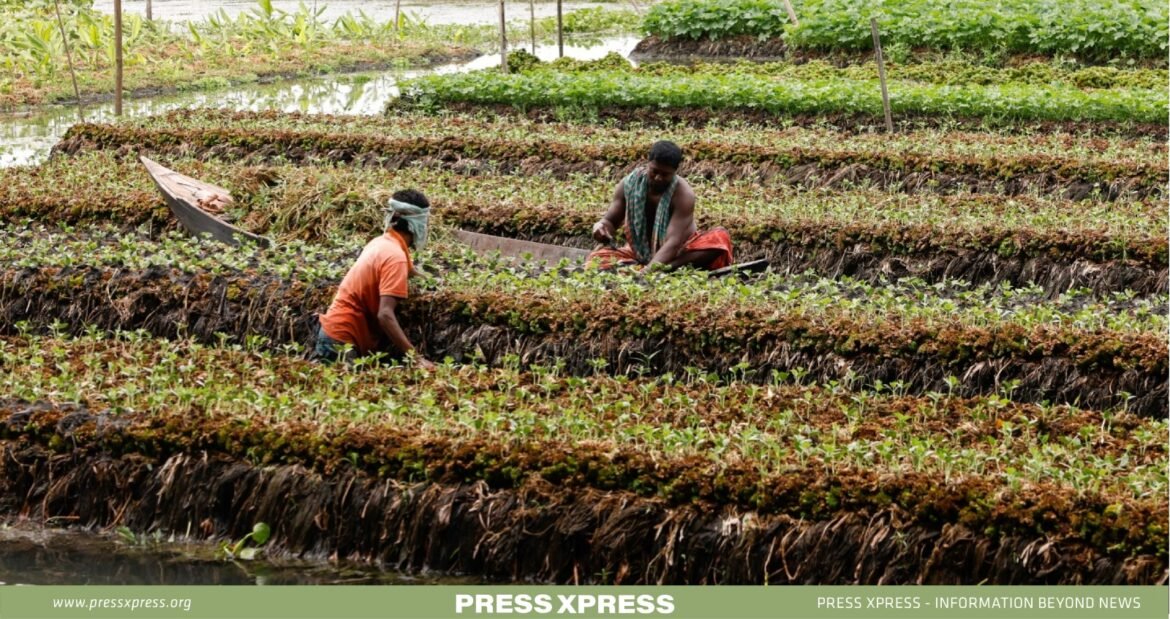The Bangladesh Agricultural Development Corporation (BADC) is currently implementing the ‘Cumilla-Chandpur-Brahmanbaria Irrigation Development Project’ at a cost of Tk 365.46 crore, marking a significant step towards agricultural prosperity. Already proving to be a game-changer for 34 upazilas across three districts, the project’s completion by 2024 is expected to empower approximately 1.21 lakh farmers to protect their crops on 26,939 hectares. This anticipates an annual additional production of around 1.35 lakh tonnes of food grains in the project area, as reported by the project authority and beneficiary farmers.
You can also read: Digital Evolution of Bangladesh’s Financial Landscape
Farmers in the Rajapur union, under Burichang upazila in Cumilla district, are already benefiting from the initiative. They are optimistic about leading a tranquil life by cultivating three crops throughout the year on lands that were submerged for the past two decades. A local farmer expressed gratitude for the transformation, highlighting how waterlogging, a scourge in their lives just two years ago, has been successfully eliminated by the BADC canal. This has liberated them from the curse, allowing extensive paddy cultivation and ending the additional costs and challenges associated with waterlogged lands.
Project At a Glance

Outcomes Of The Projects
The positive impact extends beyond Payater Khal, reaching 26,939 hectares of land in Cumilla, Brahmanbaria, and Chandpur, now benefiting from irrigation facilities. Through the installation of 30 solar water tanks, 114 electric LLPs, and 50 submersible pumps, the project area sees an annual increase of 134,695 tonnes in food grain production, benefitting 120,790 farmers.
The excavation of the Kazipara canal in Chandina and the Kanail canal in the Chauddagram upazila of Cumilla has benefited approximately 3,000 farmers in two upazilas. Additionally, the construction of the ‘Padua Crop Protection Dam in Daudkandi’ has prompted numerous farmers to return to their fields, eliminating littering and waterlogging issues.
The construction of the dam has not only enhanced connectivity among three villages but has also eliminated the need for boat rides in the area. Farmers in Daudkandi’s Bara Harina Ramayetkandi express relief from littering and waterlogging issues due to the implementation of underground drainage pipes.
The 1.5km Sundari canal in Meghdair village, Chandpur’s Kachua upazila, had not been excavated for 50 years, leading to the accumulation of silt and mud. The canal’s renovation has brought joy to local farmers, who eagerly anticipate a successful harvest. The newly-built drainage system in the Satpara area of Akhaura upazila in Brahmanbaria enables farmers to irrigate their 100 bighas of land by sourcing water from other locations.
According to the Department of Agricultural Extension (DAE), the cultivated land in the three districts has increased from 151,886 hectares to 178,825 hectares due to canal excavation and improved irrigation facilities.
It May Be A Model For Other Wetlands Of Bangladesh
The ‘Comilla-Chandpur-Brahmanbaria Irrigation Development Project’ in Bangladesh can serve as a model for other wetlands in Bangladesh for agricultural development and rural prosperity. A wetland is a place or area whose soil is seasonally or permanently wet. According to the Ramsar Convention, wetlands refer to low-lying land; whose source of water is natural or artificial; Water stability year-round or seasonal; Water still or moving; Fresh, semi-saline or brackish, also shallow marine areas less than 6 m deep and with little current.
Some of the important wetlands in the country are Chalan Beel, Atrai Basin, Lower Punarbhava Floodplain, Gopalganj-Khulna Beel, Surma-Kushiara Floodplain, Andhasura Bill of Naogaon Barendrabhoomi, Gumai Bill of Rangunia in Chittagong, Ariyal, an important bill in the central part of the country spread over three upazilas of Munshiganj and Dhaka districts, Dakatiya, Shitalakshya, Turag and Bangshai Bills spread over Dumuria and Fultala upazilas of Khulna, Bella Bill of Gazipur and Narsingdi districts, Gopalganj and Chandar Bill, Sunamganj, Moulvibazar, Habiganj, Sylhet, Netrokona, Kishoreganj, and Brahmanbaria, spread in Madaripur, with about 48 large haors totaling 427 haors and ‘Cumilla-Chandpur-Brahmanbaria weatland.
Challenges And Solutions: Navigating Agricultural Prosperity
Addressing Waterlogging Issues: One of the significant challenges faced by farmers in Bangladesh is waterlogging, which severely hampers crop cultivation. The project successfully tackled this issue by re-excavating canals, leading to the reclamation of thousands of acres of waterlogged land. This approach can be replicated in other regions facing similar problems.
Enhancing Agricultural Productivity: The project focused on activities such as canal re-excavation, construction of embankments, installation of drainage pipelines, and the use of efficient irrigation systems. These interventions have resulted in a substantial increase in cultivable land and improved irrigation facilities, leading to a significant boost in agricultural productivity. This model can serve as an example for other agricultural development initiatives.
Utilization of Renewable Energy: The project incorporated the use of solar-powered pumps, contributing to sustainable and eco-friendly agricultural practices. This aspect of the project can inspire other initiatives to explore renewable energy solutions in agriculture, aligning with broader sustainability goals.
Multipurpose Use of Infrastructure: The repurposing of canal embankments as roads and the positive impact on activities like fish and poultry farming and vegetable cultivation showcase the multi-functional use of infrastructure. This model demonstrates how agricultural projects can have broader socio-economic benefits beyond crop cultivation.
Community Engagement and Impact: The testimonials from local farmers highlight the tangible positive impact on their lives. Farmers who were previously unable to cultivate certain crops due to waterlogging are now enjoying higher yields. This project’s success in improving the livelihoods of farmers can serve as motivation for similar projects in other regions.
Infrastructure Development for Connectivity: The project not only focused on irrigation but also contributed to enhanced connectivity through the construction of dams and canal excavations. This approach can be emulated in other regions to improve overall infrastructure and accessibility.
Training Centers for Skill Development: The inauguration of a training center as part of the project indicates a focus on skill development. This aspect can be replicated in other projects to ensure that local communities are equipped with the knowledge and skills needed for sustainable agricultural practices.
Measurable Outcomes: The article provides specific data on the increase in cultivable land, additional food grain production, and the number of farmers benefiting from the project. This emphasis on measurable outcomes can serve as a benchmark for the evaluation of other agricultural development initiatives.
Government-Led Initiatives: The involvement of the Bangladesh Agricultural Development Corporation (BADC) and the Ministry of Agriculture in spearheading the project demonstrates the importance of government-led initiatives in achieving large-scale agricultural development. This model emphasizes the role of governmental bodies in driving transformative changes in the agricultural sector.


